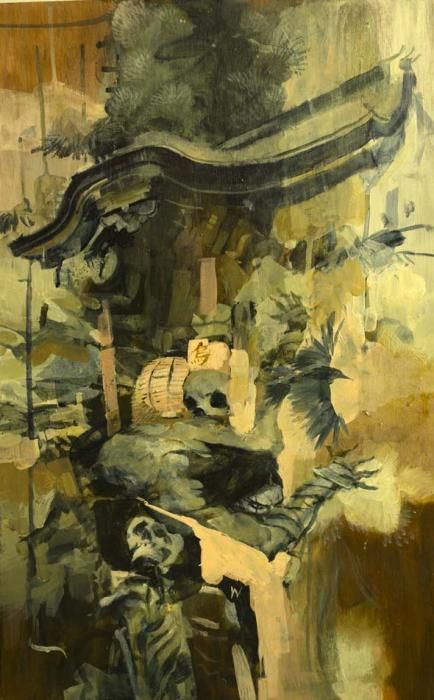The strongest component of IDW's revival of James O'Barr's "The Crow" written by John Shirley is Kevin Colden's art. Panel-to-panel transitions are smooth and Colden has a great sense of background light and depth. Certain panels have such pleasing composition that they stand alone as poetic ink paintings. The shadows and silhouettes in his backgrounds are vibrant with expression and articulation. Details like tousled bed linens and distant, drizzly city skylines are rendered in dry, charcoal-like strokes that seem charged with turbulence and longing.
Unfortunately, Colden's artwork is obscured and diminished by Matthew Wilson's colors. Usually, a reader wouldn't be able to make this comparison easily, but preview pages for "The Crow: Death and Rebirth" #1 were released in black and white. It's terrible when art looks worse after being colored and the decision to go with digital coloring was not ideal. Think of Frank Miller's bold accent colors in "Sin City", or Jon J. Muth's delicate washes of watercolors in "Sandman" #74. Those restrained approaches allow expressive, heavily inked brushwork to shine. This may be unduly harsh on Wilson, since Miller and Muth colored their own work, but the colorist's overuse of sickly gray-greens and warm magentas doesn't help. There are exceptions -- one interior is colored beautifully, with dark teal shadows in harmony with the haloed yellow of an overturned incandescent lamp -- but for the most part, the colors and the inks clash, to the detriment of the art as a whole.
John Shirley co-wrote the cult film adaptation of "The Crow " and is a well-known science fiction novelist, making him an obvious choice for the other half of the creative team. His writing skill is clear in his suspenseful pacing, but his plotting and characterization in "The Crow: Death and Rebirth" #1 are weak.
Readers will guess some overarching plot twists within the first third of the issue, and Shirley's villains are flat archetypes of evil old greedy people who are drunk on money and power. The female villain, Hendra, is a stereotypical crone. One scene has her screeching at one of her lackeys while being injected with botox. Shirley also makes Hendra German for seemingly no reason, so her characterization thus far is flirting precariously with racial stereotypes.
The heroic characters have more dimension to them, but it's too bad there isn't more interaction shown between young lovers Haruko and Jamie, or even Jamie and Haruko's father. The sparkling dialogue between them is the best in the issue. Once the tragedy is in motion, however, Jamie's lines are far more stilted and melodramatic. It suits his transformation into The Crow, a mythic figure, but it is also ridiculous, as if a friend began monologuing in archaic language.
Shirley's use of technology as a plot device is uninspired. Shirley is a cyberpunk author, so there's reason to expect that he would have a thoughtful, innovative role for technology to play. Instead, science is the method by which the unscrupulous new technology class will execute their unholy crimes on nature. Tellingly, the hero of the story sticks to katanas.
The re-setting "The Crow" in Japan is a good twist, but must every story set in Japan feature traditional martial arts? Sure, The Crow using katanas will be awesome, but it's also fan service. Shirley's weaving of Shinto motifs with O'Barr's established iconography is more subtle use of his setting. In Japanese mythology, the Yatagarusu, or eight-span Jungle crow, is a sign of the will of Heaven in human affairs. In Shirley's story, the crow is a watchdog and witness as well as a catalyst of resurrection and vengeance. Themes of death and rebirth are also less clear-cut in Shirley's story than in O'Barr's "The Crow." Further issues may show if Shirley will add more substance to this incarnation of the titular anti-hero, but this first issue doesn't deliver much more than homage mixed with existing tropes.

